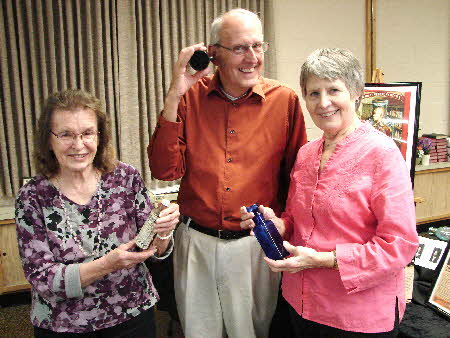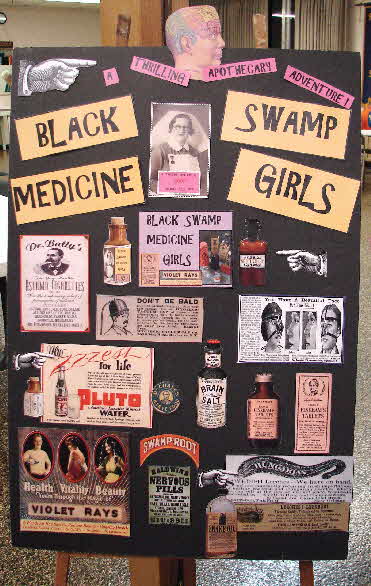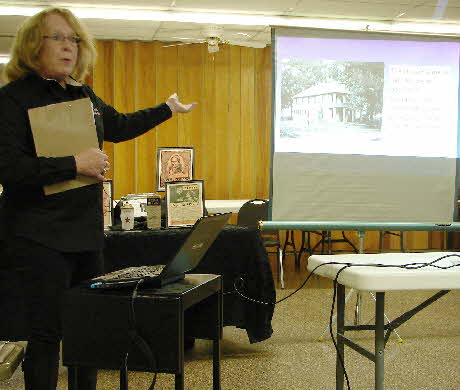|
Stryker heritage members hear how old medicine often made people worse 
Members of the Stryker Area Heritage Council got a dose of just how bad some early medical remedies were during their annual meeting on Thursday, Nov. 10, 2016.
However, before the Black Swamp Medicine Girls dispensed examples of old tonics and elixirs used by area residents, the crowd was treated to a review of the major activities of the council over the past year.
Stryker Mayor Joe Beck said the Stryker Area Heritage Council is an active group and he and the village council like to hear about all the work going on, particularly in the museum housed in the former train depot.
“One of the things that I’ve seen in the last several years, is that the village as well as the heritage council seem to work pretty well together to try and keep that donation that Erie Sauder gave, that depot, up to where it needs to be. It’s part of Stryker’s history,” the mayor said.
“The work that you guys do is extremely important. Not just to remember maybe what you guys have seen or your parents or grandparents, but for the younger generation,” he told the group.
Heritage council President Terry Wieland listed some of the accomplishments of the council in the past year. He pointed to the full day of presentations that were held on Sept. 24 commemorating the 100th anniversary of the death of William Knight. Wieland said the day’s event included the dedication of two new flagpoles in the Stryker cemetery by the gravesite of the late Stryker resident who received the Medal of Honor.
He also noted donations the council received of local history that are displayed in the former train depot. He said that anyone who would like a tour of the depot should contact a trustee who will set it up.
Wieland said the council was pleased to help the Stryker Fire Department by organizing a parade held for their first annual Jaws Jam in August.
He said the council likes that there are a large number of people using their Facebook page and their website at www.strykerhistory.org.
There is a project that he said the council needs help to complete. They would like to restore a brick walkway at the depot, and have had bricks donated to them. However, they need to find someone with the expertise to place them in the ground.
He said he hopes someone will contact a trustee who would be willing to help them with the project.
The members held an election for three trustee positions. They re-elected Helen Bell, Judy Keller and Bill Priest to serve new three-year terms.
Following their short business session, the attention of the group shifted to medicines and medical treatments of the residents in the area in the 19th and early 20th centuries when the area was known as the Great Black Swamp (much like the ones shown in the photo above of - from left to right - SAHC Secretary Helen Bell, SAHC President Terry Wieland and SAHC Treasurer Sue Buehrer).
The Black Swamp Medicine Girls, Susan Wisehan and Jeanne Caryer, said the people in the area suffered from poor diets and poor living conditions. That contributed to a number of illnesses such as malaria, also known as ague.
While there were many patent medicines that claimed to cure malaria, people learned that the only effective treatment at the time was quinine and often had it sitting at the dining table, shaking it on their food like salt.
Cholera was another major illness among early residents and for those traveling along the canals.
One of the treatments used for cholera patients in the 1800’s was calomel. Later it was discovered that calomel contained mercury, so it’s not known how many people actually died from cholera or from mercury poisoning due to the treatment.
Since there were not many doctors in the area and many of those doctors received only a four or five months training, people often turned to home remedies to treat their sicknesses. Generally the mother of the family administered these concoctions from recipes handed down from generation to generation.
“Home remedies made by the woman of the house were horrible tasting, stinging, gagging and strong,” Wisehan said. “Patients were treated with plasters and poultices and usually felt better after they were removed!” she remarked.
“The patient was usually cured after one dose or treatment because the thought of another round of treatments scared the illness out of the patient,” she quipped.
A supply of mineral water was discovered in Stryker, and Caryer, as shown in the phot to the left, pointed out people came to the Stryker mineral bath house to avail themselves of the water.
She also mentioned Pluto water that was taken from a mineral spring at French Lick, Indiana. She said train cars full of people visited the site to drink the water. It was bottled and sold extensively throughout the country.
In 1971, she said the manufacturers discovered Pluto water naturally contained lithium, a controlled substance that is used to treat bipolar disorder, and they discontinued selling it.
Each person who attended the program received a packet of trade cards promoting all kinds of remedies sold by local Stryker stores. Caryer said trade cards were particularly popular in the 1880’s to 1900. They were collected, kept in scrapbooks and used to decorate the homes of people until advertising in magazines and newspapers became more popular.
One of the cards promoted Lydia E. Pinkham’s Vegetable Compound, which was available at Stubbs and Rumsey Druggists in Stryker. Caryer said the compound brought in millions of dollars for Lydia Pinkham who touted it as taking care of female complaints. Among the maladies it claimed to cure, the card lists bloating, headaches, nervous prostration, general debility, sleeplessness depression and indigestion. People often said “there was a baby in every bottle!”
Caryer said the compound was sold during the Temperence movement, and like many patent medicines, it contained alcohol. The Lydia Pinkham Vegetable Compound was no different, Caryer said, with a 36% content level!
While it may have been reconfigured, Caryer said the compound is still available today.
After the program, the ladies invited audience members to view their collection of medicine bottles and medical remedies and ask any questions they had about other treatments.
|

